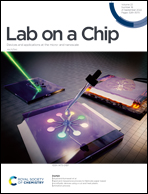Characterization of nanoparticle size distributions using a microfluidic device with integrated optical microcavities†
Abstract
We introduce a method for analyzing the physical properties of nanoparticles in fluids via the competition between viscous drag and optical forces in a microfluidic device with integrated optical microcavities. The optical microcavity acts as a combined optical trap and sensor, such that the time duration of individual particle detection events can be used as a measure of particle size via a parameter which represents the dielectric polarizability per unit radius. Characterization of polymer particles with diameters as small as 140 nm is reported, below that used in previous optical sorting approaches and in the size range of interest for nanomedicine. This technique could be applied in combination with other analytic techniques to provide a detailed physical characterization of particles in solution.



 Please wait while we load your content...
Please wait while we load your content...